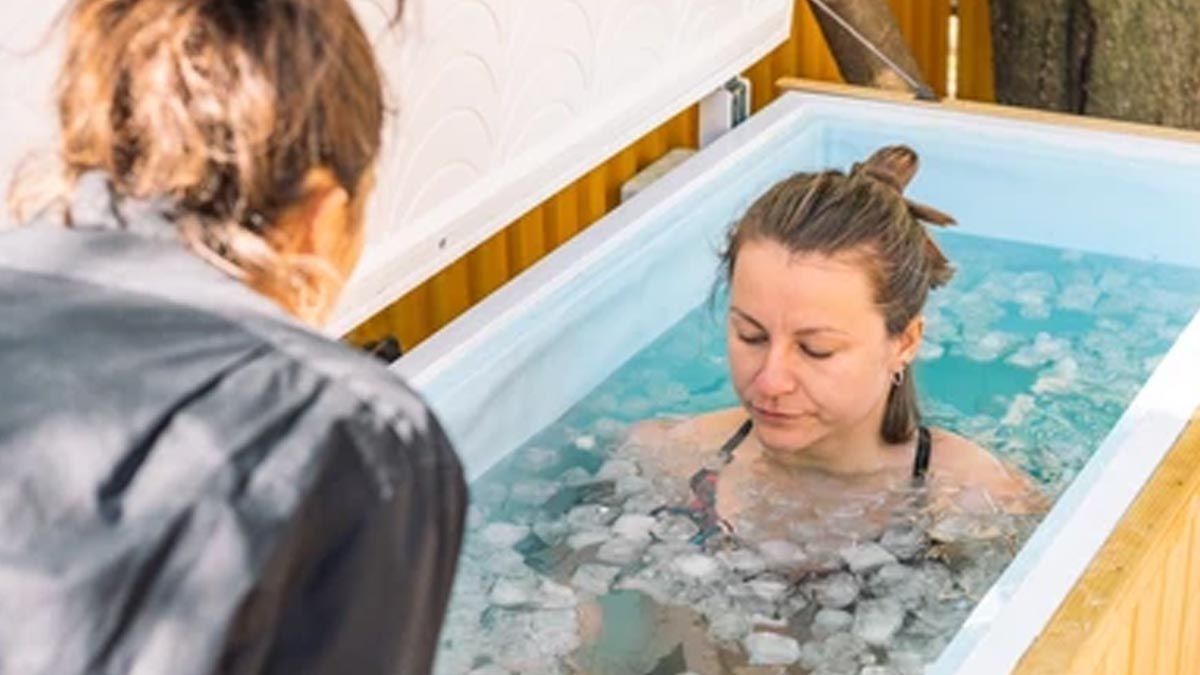
Ice baths have become the talk of the town. From fitness influencers to Bollywood celebrities, there is constant chatter around how it helps reduce stress and muscle soreness. Many athletes also take this remedy to speed up their recovery. However, whether or not ice baths are beneficial is still a debated topic. We spoke to Dr Thejaswi G, Physiotherapist, Aster Women and Children Hospital, Whitefield, Bengaluru, to help get some answers and to also understand how it works.
Table of Content:-
Also Read: Can Soaking Your Feet In Hot Water Relieve Migraine? We Asked An Expert
How Does An Ice Bath Work?

“Ice baths, also known as cold water immersion, are a therapeutic practice that involves immersing the body in cold water, where the temperature is typically between 10-15 degrees Celsius, for around 10–20 minutes,” says Dr Thejaswi, sharing that they work by shrinking blood vessels, which reduces swelling and makes pain go away, promoting faster recovery post-workout.
She adds that the process triggers vasoconstriction, decreasing blood flow to muscles and alleviating swelling, while also acting as a natural analgesic to numb pain sensations.
Additionally, ice baths trigger the release of endorphins, which are neurotransmitters known for their ability to induce feelings of well-being and relaxation.
Do Ice Baths Really Work?
According to Dr Thejaswi, ice baths may provide various health benefits.
“When you soak in cold water, especially after exercising, it can help decrease inflammation and swelling in your muscles,” she says, adding that the cold water can sometimes also numb the feeling of pain.
She further states that ice baths offer several potential benefits, including reduced muscle soreness, enhanced recovery, and temporary pain relief.
According to her, the cold temperature can constrict blood vessels and decrease tissue damage. Moreover, exposure to cold may temporarily numb nerve endings, providing relief from pain and discomfort in sore or injured muscles. Improved circulation and psychological benefits, such as a sense of refreshment and relaxation, are also reported by some individuals.
However, scientific evidence supporting these benefits is still evolving, and caution should be exercised, particularly for those with medical conditions.
The doctor recommends considering your goals and consulting a doctor before taking an icy dip, as ice baths aren't suitable for everyone.
Also Read: Ice Packs For Health: Here Is How You Can Use Ice Packs To Promote Health And Wellness
Should Some People Avoid Doing It?

It is important to note that ice baths aren’t for everyone, and some people should avoid indulging in them or consult a doctor before taking part in them.
“People with pre-existing conditions like heart disease, high blood pressure, or diabetes should avoid them due to the potential strain on the heart and circulatory system caused by the cold shock,” says Dr Thejaswi.
Additionally, pregnant women should also abstain, as research suggests possible risks to the foetus, the doctor adds.
Anyone with open wounds or infections should also avoid ice baths, as the cold water can hinder healing and increase infection risk.
If you have a cold intolerance or sensitivity, it is best to avoid it to prevent discomfort or adverse reactions.
How To Safely Take An Ice Bath?

Preparing for an ice bath requires careful attention to ensure safety and effectiveness. Here are some steps to properly take an ice bath and reap its potential benefits for recovery and muscle soreness relief:
- Fill a tub with cold water, aiming for a temperature between 10 and 15 degrees. You can add ice to lower the temperature, but avoid direct contact with ice to prevent frostbite.
- Before getting into the bath, warm up your body with light exercises or a warm shower.
- Slowly lower yourself into the tub, immersing your body up to your chest or neck. Take your time and allow your body to adjust to the cold temperature.
- Aim to stay in the ice bath for about 10–15 minutes. During this time, keep moving your arms and legs to improve circulation and prevent numbness.
- Pay attention to how your body responds to the cold water. If you start feeling uncomfortable or experience any pain or dizziness, exit the bath immediately.
- When your time is up, slowly exit the bath and avoid sudden movements. Wrap yourself in dry clothes and blankets to warm up gradually.
Remember, before attempting ice baths, especially if you have any underlying health conditions, consult with a healthcare professional to ensure it's safe for you, Dr Thejaswi concludes.
Also watch this video
How we keep this article up to date:
We work with experts and keep a close eye on the latest in health and wellness. Whenever there is a new research or helpful information, we update our articles with accurate and useful advice.
Current Version